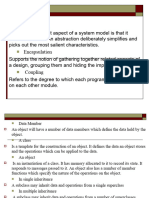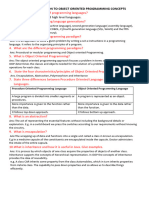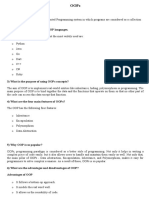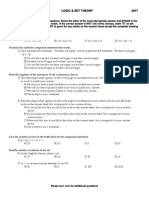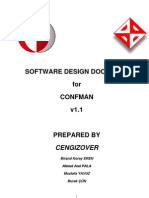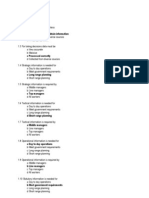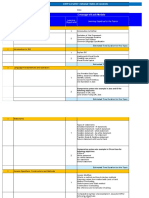0 ratings0% found this document useful (0 votes)
44 viewsElementary Concepts of Object Class
This document discusses elementary concepts of object-oriented programming including classes, objects, abstraction, encapsulation, inheritance, and polymorphism. It defines key terms like class, object, abstraction, encapsulation, inheritance, polymorphism, and discusses the differences between procedural programming and object-oriented programming. Several questions and answers are also provided to further explain concepts of OOP like classes, objects, methods, data hiding, nested classes, and the difference between base and derived classes.
Uploaded by
ARNAV ARNAVCopyright
© © All Rights Reserved
Available Formats
Download as PDF, TXT or read online on Scribd
0 ratings0% found this document useful (0 votes)
44 viewsElementary Concepts of Object Class
This document discusses elementary concepts of object-oriented programming including classes, objects, abstraction, encapsulation, inheritance, and polymorphism. It defines key terms like class, object, abstraction, encapsulation, inheritance, polymorphism, and discusses the differences between procedural programming and object-oriented programming. Several questions and answers are also provided to further explain concepts of OOP like classes, objects, methods, data hiding, nested classes, and the difference between base and derived classes.
Uploaded by
ARNAV ARNAVCopyright
© © All Rights Reserved
Available Formats
Download as PDF, TXT or read online on Scribd
You are on page 1/ 7
Elementary Concepts
of Object Class
Modeling entities and their behaviour by
objects. A class as a specification of
objects and as an object factory,
computation as message passing/function
call between objects (many example
should be done to illustrate this). Object
encapsulate state (attribute) and have
behaviors (functions). Class as a user
defined type.
Q. What is an Object?
Ans: An Object is an identifiable entity
with some characteristics and behavior.
E.g. take a class ‘Car’. A car class has
characteristics like colour, gears, power,
length etc. now we create the object of that
class ‘Car’ namely ‘Indica’.
Q. What is OOP? What are the
features/concepts in OOP’s?
OR
Name any two OOP’S principles.
Ans: The Object Oriented Programming
Paradigm is the latest in the software
development and the most adopted one in
the programming development. The
Paradigm means organising principle of a
program. It is an approach to
programming. The concepts of OOP’s are:
(1) Data Abstraction (2) Data
Encapsulation (3) Modularity (4)
Inheritance (5) Polymorphism.
Q. Explain all the Concepts of OOP’s?
Ans: Abstraction: It refers to the act of
representing essential features without
including the background details or
explanation. Encapsulation: It is the way of
combining both data and the function that
operates on the data under a single unit.
Modularity: It is the property of a system
that has been decomposed into a set of
cohesive and loosely couple modules.
Inheritance: It is the capability of one class
of thing to inherit properties from another
class. Polymorphism: It is the ability for a
message or data to be processed in more
than one form.
Q. What are the advantages of OOP’s?
Ans: (1) Elimination of redundant coding
system and usage of existing classes
through inheritance. (2) Program can be
developed by sharing existing modules. (3)
Possibilities of multiple instance of an
objects without any interference. (4)
Security of data values from other segment
of the program through data hiding.
Q. What is Class? How Object is related to
the Class?
Ans: A Class represent a set of Objects
that share common characteristics and
behavior. Objects are instance of a class.
The Object represents the abstraction
representation by the class in the real
sense.
Q. What is the need of a class in Java?
Ans: Classes in Java are needed to
represent real-world entities, which have
data type properties. Classes provide
convenient methods for packing together a
group of logical related data items and
functions that work on them. In java the
data items are called fields & the functions
are called methods.
Q. What are Methods? How are these
related to an Objects?
Ans: A Method is an operation associated
to an Object. The behavior of an Object is
represented through associated function,
which are called Methods.
Q. Point out the differences between
Procedural Programming and Object
Oriented Programming.
Ans: Procedural programming aims more
at procedures. The emphasis is a doing
things rather then the data being used. In
procedural Programming parading data are
shared among all the functions
participating thereby risking data safety
and security. Object Oriented
Programming is based on principles of
data hiding, abstraction, inheritance and
polymorphism. It implements programs
using classes and objects, In OOP’s data
and procedure both given equal
importance. Data and functions are
encapsulated to ensure data safety and
security.
Q. What is an abstraction?
Ans: An abstraction is a named collection
of attributes and behaviors required to
represent an entity or concept for some
particular problem domain.
Q. What is inheritance and how it is useful
in Java.
Ans: It is process by which objects of one
class acquire the properties of objects of
another class. Inheritance supports the
concepts of hierarchical representation. In
OOP the concepts of inheritance provides
the idea of reusability.
Q. What role does polymorphism play as
java feature?
Ans: It mean the ability to take more than
one form. For example, an operation, many
types of data used in the operation.
Q. What is Data hiding?
Ans: Data Hiding means restricting the
accessibility of data associated with an
object in such a way that it can be used
only through the member methods of the
object.
Q. What are nested classes?
Ans: It is possible to define a class within
another class, such classes are known as
nested classes. A nested class has access to
the members including private members of
the class in which it is nested. However the
enclosing class not have access to the
members of the nested class.
Q. Differentiate between base and derived
class.
Ans: BASE CLASS – A class from which
another class inherits (Also called SUPER
CLASS)
DERIVED CLASS – A class inheriting
properties from another class. (Also called
SUB CLASS)
You might also like
- Issa A. Turay - 18290214 - CS Final Yr.No ratings yetIssa A. Turay - 18290214 - CS Final Yr.5 pages
- Mailam Engineering College Oop-Cs8392 - Unit - INo ratings yetMailam Engineering College Oop-Cs8392 - Unit - I79 pages
- Lesson Summary Notes 1-10-OBJECT ORIENTED PROGRAMMING SLIDES NOTES UPDATEDNo ratings yetLesson Summary Notes 1-10-OBJECT ORIENTED PROGRAMMING SLIDES NOTES UPDATED116 pages
- Object-Oriented-Programming-Using-C-Characteristics-of-Object-Oriented-Programming-2No ratings yetObject-Oriented-Programming-Using-C-Characteristics-of-Object-Oriented-Programming-211 pages
- (B) What Is Object Oriented Programming ?No ratings yet(B) What Is Object Oriented Programming ?4 pages
- Introducton To Object Oriented ProgrammingNo ratings yetIntroducton To Object Oriented Programming9 pages
- CS8392 - Object Oriented Programming Question Bank100% (1)CS8392 - Object Oriented Programming Question Bank26 pages
- Java Viva Question and Answer: Q) What Is Object Oriented Language ?No ratings yetJava Viva Question and Answer: Q) What Is Object Oriented Language ?35 pages
- Question&Answer NEET2020 (Code-G5) AKANH PDFNo ratings yetQuestion&Answer NEET2020 (Code-G5) AKANH PDF21 pages
- All Summer in A Day: Science Fiction. Best Known For The 1953 DystopianNo ratings yetAll Summer in A Day: Science Fiction. Best Known For The 1953 Dystopian4 pages
- Gggggggggggdvvvvvvvvvvvgvcxthef PatriotNo ratings yetGggggggggggdvvvvvvvvvvvgvcxthef Patriot10 pages
- Abu Ben Adhein: Abou Ben Adhem: About The PoemNo ratings yetAbu Ben Adhein: Abou Ben Adhem: About The Poem6 pages
- I Know Why The Caged Bird Sings: About The PoemNo ratings yetI Know Why The Caged Bird Sings: About The Poem7 pages
- Bangle Seller: The Bangle Sellers by Sarojini Naidu: About The PoemNo ratings yetBangle Seller: The Bangle Sellers by Sarojini Naidu: About The Poem6 pages
- The United Nations - Origin and Purpose: Role of The UN in Preserving World PeaceNo ratings yetThe United Nations - Origin and Purpose: Role of The UN in Preserving World Peace4 pages
- The National Movement and Mahatma GandhijhhhhNo ratings yetThe National Movement and Mahatma Gandhijhhhh16 pages
- The Principal Organs and Agencies of The Un: United Nations OrganisationNo ratings yetThe Principal Organs and Agencies of The Un: United Nations Organisation6 pages
- Quit India Movement and Subhash Chandra Bose: Important National Events Between 1922 - 1939No ratings yetQuit India Movement and Subhash Chandra Bose: Important National Events Between 1922 - 193914 pages
- Reverse Engineering Of: Object Oriented CodeNo ratings yetReverse Engineering Of: Object Oriented Code2 pages
- Test 6: Unit1 and Unit 2: A Mathematical-Model With A Collection of Operations Defined On That Model Is CalledNo ratings yetTest 6: Unit1 and Unit 2: A Mathematical-Model With A Collection of Operations Defined On That Model Is Called66 pages
- Spring Boot Introduction: Spring MVC, Spring DataNo ratings yetSpring Boot Introduction: Spring MVC, Spring Data47 pages
- Object Oriented Programming Using C++ CST-157 Unit-Iii Files Chapter-9No ratings yetObject Oriented Programming Using C++ CST-157 Unit-Iii Files Chapter-929 pages
- (Ebook) Introduction to Java Programming. Comprehensive Version by Y. Daniel Liang ISBN 9780133761313, 0133761312 pdf download100% (2)(Ebook) Introduction to Java Programming. Comprehensive Version by Y. Daniel Liang ISBN 9780133761313, 0133761312 pdf download60 pages
- Multiple Choice Question (MCQ) : Computer Fundamental Interview Questions Set-14No ratings yetMultiple Choice Question (MCQ) : Computer Fundamental Interview Questions Set-1418 pages
- Aneka Cloud Application Platform and Its Integration With Windows AzureNo ratings yetAneka Cloud Application Platform and Its Integration With Windows Azure30 pages
- Lesson Summary Notes 1-10-OBJECT ORIENTED PROGRAMMING SLIDES NOTES UPDATEDLesson Summary Notes 1-10-OBJECT ORIENTED PROGRAMMING SLIDES NOTES UPDATED
- Object-Oriented-Programming-Using-C-Characteristics-of-Object-Oriented-Programming-2Object-Oriented-Programming-Using-C-Characteristics-of-Object-Oriented-Programming-2
- CS8392 - Object Oriented Programming Question BankCS8392 - Object Oriented Programming Question Bank
- Java Viva Question and Answer: Q) What Is Object Oriented Language ?Java Viva Question and Answer: Q) What Is Object Oriented Language ?
- A Concise Guide to Object Orientated ProgrammingFrom EverandA Concise Guide to Object Orientated Programming
- All Summer in A Day: Science Fiction. Best Known For The 1953 DystopianAll Summer in A Day: Science Fiction. Best Known For The 1953 Dystopian
- Bangle Seller: The Bangle Sellers by Sarojini Naidu: About The PoemBangle Seller: The Bangle Sellers by Sarojini Naidu: About The Poem
- The United Nations - Origin and Purpose: Role of The UN in Preserving World PeaceThe United Nations - Origin and Purpose: Role of The UN in Preserving World Peace
- The Principal Organs and Agencies of The Un: United Nations OrganisationThe Principal Organs and Agencies of The Un: United Nations Organisation
- Quit India Movement and Subhash Chandra Bose: Important National Events Between 1922 - 1939Quit India Movement and Subhash Chandra Bose: Important National Events Between 1922 - 1939
- Test 6: Unit1 and Unit 2: A Mathematical-Model With A Collection of Operations Defined On That Model Is CalledTest 6: Unit1 and Unit 2: A Mathematical-Model With A Collection of Operations Defined On That Model Is Called
- Object Oriented Programming Using C++ CST-157 Unit-Iii Files Chapter-9Object Oriented Programming Using C++ CST-157 Unit-Iii Files Chapter-9
- (Ebook) Introduction to Java Programming. Comprehensive Version by Y. Daniel Liang ISBN 9780133761313, 0133761312 pdf download(Ebook) Introduction to Java Programming. Comprehensive Version by Y. Daniel Liang ISBN 9780133761313, 0133761312 pdf download
- Multiple Choice Question (MCQ) : Computer Fundamental Interview Questions Set-14Multiple Choice Question (MCQ) : Computer Fundamental Interview Questions Set-14
- Aneka Cloud Application Platform and Its Integration With Windows AzureAneka Cloud Application Platform and Its Integration With Windows Azure
























